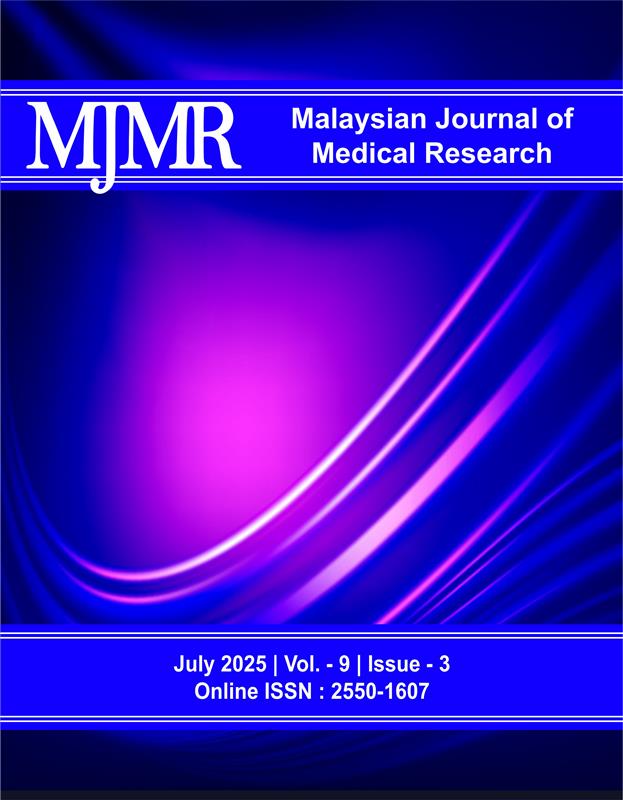Clinical Case Studies in Managing Diabetic Foot Ulcers by Using Stabilised Hypochlorous Acid Wound Cleaning and Irrigation Solution
DOI:
https://doi.org/10.31674/mjmr.2025.v09i03.011Abstract
Diabetic foot ulcers (DFUs) are an increasingly health concern and pose a significant burden on healthcare providers and patients equally. Managing this chronic wound needs to take into consideration the choice of wound care solution that is not only effective but also provides a safe healing environment without causing any adverse effects on healing tissues. This case series focuses on the use of stabilized super-oxidised hypochlorous acid in wound cleaning, debridement and irrigation in the managing of DFUs and assessing of the wound healing progress. A total of three patients with diabetic foot ulcer were subjected to wound cleansing using stabilised super- oxidised hypochlorous acid solution throughout the study period, detailing wound progression, treatment protocols, and healing outcomes. Results show that the use of stabilised HOCl (Hypochlorous acid) wound irrigation solution prevented risk of infection in these chronic wounds thus allowing natural wound healing to take place without any adverse effects. These findings support the integration of HOCl-based wound care into standard DFU treatment practices. Adherence to follow-up care and complete wound management strategies is crucial, and the positive outcome seen in these cases highlights the potential relevance of stabilised super-oxidised HOCl wound cleaning solution in the management of diabetic foot ulcers.
Keywords:
Attitude, Cone Beam Computed Tomography, Dental Students, KnowledgeDownloads
References
Armstrong, D. G., Bohn, G., Glat, P., Kavros, S. J., Kirsner, R., Snyder, R., & Tettelbach, W. (2015). Expert Recommendations for the Use of Hypochlorous Solution: Science and Clinical Application. Ostomy/wound management, 61(5), S2-S19. Retrieved from: https://europepmc.org/article/med/28692424. Accessed on 18th July 2024.
Britto, E. J., Nezwek, T. A., Popowicz, P., & Robins, M. (2025). Wound dressings. In StatPearls. StatPearls Publishing. Retrieved from: https://europepmc.org/article/nbk/nbk470199. Accessed on 19th August 2024.
da Cruz Nizer, W. S., Inkovskiy, V., & Overhage, J. (2020). Surviving reactive chlorine stress: responses of gram-negative bacteria to hypochlorous acid. Microorganisms, 8(8). https://doi.org/10.3390/microorganisms8081220
McDermott, K., Fang, M., Boulton, A. J., Selvin, E., & Hicks, C. W. (2023). Etiology, epidemiology, and disparities in the burden of diabetic foot ulcers. Diabetes care, 46(1), 209-221. https://doi.org/10.2337/dci22-0043
Ministry of Health Malaysia. (2014). National Diabetes Registry report, volume 1 (2009–2012). Non-Communicable Disease Section, Disease Control Division, Department of Public Health, Ministry of Health Malaysia. Retrieved From: https://www.moh.gov.my/moh/resources/Penerbitan/Rujukan/NCD/Diabetes/National_Diabetes_Registry_Report_Vol_1_2009_2012.pdf. Accessed on 28th June 2024.
Natarelli, N., Nong, Y., Maloh, J., & Sivamani, R. (2022). Hypochlorous acid: Applications in dermatology. Journal of Integrative Dermatology. Retrieved from: https://www.jintegrativederm.org/article/56663-hypochlorous-acid-applications-in-dermatology. Accessed on 19th July 2024.
Robson, M. C., Payne, W. G., Ko, F., Mentis, M., Donati, G., Shafii, S. M., ... & Bassiri, M. (2007). Hypochlorous acid as a potential wound care agent: part II. Stabilized hypochlorous acid: its role in decreasing tissue bacterial bioburden and overcoming the inhibition of infection on wound healing. Journal of Burns and Wounds, 6.
Roos, H. (2022). The Use of Hypochlorous Acid in the Healing of a Diabetic Foot Ulcer. International Journal of Biomedical Engineering and Clinical Science, 8(4), 53-56. https://doi.org/10.11648/j.ijbecs.20220804.13
Wang, L., Bassiri, M., Najafi, R., Najafi, K., Yang, J., Khosrovi, B., ... & Robson, M. C. (2007). Hypochlorous acid as a potential wound care agent: part I. Stabilized hypochlorous acid: a component of the inorganic armamentarium of innate immunity. Journal of burns and wounds, 6, e5.
Wolcott, R., & Fletcher, J. (2008). The role of wound cleansing in the management of wounds. Inflammation, 17(8), 333-41. Retrieved from: https://wounds-me.com/wp-content/uploads/2023/02/mez1-1-33-8.pdf. Accessed on 30th May 2024.
World Health Organization (WHO). (2023). Hypochlorous acid (HOCl): Assessment on skin, eye, and respiratory safety of stabilized neutral HOCl solutions. Retrieved from: https://cdn.who.int/media/docs/default-source/2025-eml-expert-committee/addition-of-new-medicines/a.16_hypochlorous-acid.pdf. Accessed on 18th June 2024.
Published
How to Cite
Issue
Section
License
Copyright (c) 2025 Malaysian Journal of Medical Research (MJMR)

This work is licensed under a Creative Commons Attribution-NonCommercial-NoDerivatives 4.0 International License.























